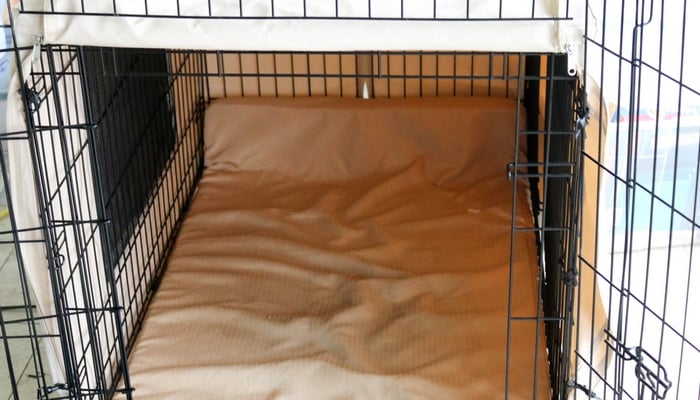16 Effective Crating Tips to Keep Your Dogs Inside
Crate training a dog can be an effective method in providing the feel of peace and safety for dogs in your absence. It’s also for your peace of mind that your isn’t chasing after things or eating sofa cushions.
Contrary to popular belief, dogs are not den animals in the nature; however, they have been domesticated by people to the point where they seek out dens today. One study with Beagles has shown how canines in fact enjoy human designed dog crates, but they need to be introduced to them gradually.
16 Tips for Crate Training a Dog Effectively
1. Choose the Right Dog Crate
Dog crates are one of the most popular and first items new pet owners buy. Fortunately or not, there are many different types available (metal, soft, plastic, travel, single or double door, with dividers or without, and more). You can also find them in several sizes, and it’s important to pick the right type and dimensions for your individual dog.
If you have a puppy, it’s recommended to go with a bigger crate that he can grow into, and use a divider to limit the space within the crate. At the very least, your dog must be able to sit and stand at full height, turn around, stretch out and lie down in a natural position. A crate that’s too big poses its own risks, so it’s crucial that you know dog crate sizes, measure your dog and refer to a sizing chart before buying.
2. It’s a Safe Place (Not the Naughty Corner)
Crating a dog is about providing pets with a safe space in which they can relax and have some peace, whether your at home or not. It should be a cozy den that the dog enjoys spending time in, or when he has had enough of the world’s stress, and would like to spend some time alone.
One mistake that owners make is to give the crate a dual purpose, using it as a ‘sin bin’ when their dog misbehaves. But crates should never be used as punishment, and crating is not the canine version of going to the “naughty corner.” If your dog associates the crate with being told-off, then he is likely to be stressed and anxious when you leave him in it in the future.
3. Create a Cozy Nest
From the very beginning, the more appealing you can make the crate look and feel for the dog, the easier the training process. Making a dog crate an irresistible space for dogs isn’t difficult, but it takes some thought and desire to do so. A few key things to consider:
- Bedding – Lining the crate with pet bedding will provide warmth and comfort. Dogs love to make their own nests, so adding special pet blankets works well too.
- Toys – Your dog will need something to keep him amused while you’re away. Chew toys and stuffed KONG toys are good, if not the best, options. But whatever you choose, simply make sure it is safe for unsupervised use.
- Location – Fido is part of the family, so make sure he feels as though he is. Putting the dog crate in a space where the family spends a lot of time will put him at ease. Make sure it’s out of direct sunlight and drafts.
4. Security Blanket
You can help more nervous pets to feel secure when crate training a dog by covering part of the crate with a blanket. This gives your pet the option of hiding away in their little den, which is especially helpful for anxious dogs during thunderstorms and fireworks. You can splurge on a crate cover if you want a more aesthetically appealing look.
5. Provide Water
Not essential for early stages of crate training, but useful later on. Depending on how long your pet stays locked in a crate, you may or may need to provide them with a water bowl. However, water bowls are easily knocked over in crates, creating a mess. If a water bowl is a necessity, it’s recommended to use a clip-on bowl, like the most often used with Midwest Homes crates, to prevent spills and mess.
6. Your Attitude
Research has shown that our dogs pick up on our moods far better than we pick up on theirs. Your pet will notice any negative vibes, whether you’re anxious about leaving him or frustrated when crate training a dog isn’t going well. When it comes to this, approach the dog crate training process with enthusiasm and patience every single time, and your dog should adjust to his new routine with confidence, and much quicker.
7. The Introduction
How you introduce a dog to his pet crate will shape the dog’s first impressions of this new space. It’s important not to rush. Put some of the dog’s favorite toys, blankets and other items inside the crate, and use treats placed by the crate door to let the dog approach it in his own time. When he’s comfortable, move the treats inside the crate. Let the dog venture inside when he’s ready, but leave the door open. Let the dog adjust first.
8. Gradually Extend the Length of Time in the Crate
When Fido becomes comfortable with entering and exiting the crate on his own, as well as staying inside with the crate door open, he’s ready for the next stage of crate training a dog – feeding inside the crate. This will reinforce that crate time is good time for your pup, while allowing you to extend his time in the kennel without any negative association.
9. Give the Dog Crate a Name
Decide on a name for the crate so that you can link it to a command (some even buy or make name tags for crates). Commands such as “Kennel” and “Crate” are clear and easy for your dog to grasp and know that it’s time to get in the crate to rest. Use this command every time your dog approaches the crate from the very beginning, and reinforce the dog’s good actions with treats and praise.
10. Begin Going Out of Sight
At a later stage, it’s time to put your dog’s favorite toys, blankets and other items inside the crate, let your pooch investigate it all and stay inside, then when he’s relaxed and focusing on his toys, you can gently shut the door.
After the first few times of closing the crate door, sit quietly by the crate for a few minutes and observe your dog. Check that your pet is still at ease. If yes, then leave the room calmly and quietly. Then return straight away and open the door, and sit by the crate again.
Repeat this routine several times over the next few days, gradually extending the period of time that you’re away from the crate up to 30 minutes. It’s a good idea to vary the times of day that you perform this drill so that your dog doesn’t anticipate a set routine. Doing this several times a day can also be helpful.
11. Ignore the Whining (At First)
Your dog may whimper, cry, howl or scratch at the crate when you leave him. These are normal reactions at the very beginning. You must ignore them to allow the dog to get comfortable and understand that he’s completely fine.
Responding will only teach your pet that he gets what he wants when he makes a fuss. He’ll soon give in when he realizes it’s not working. However, if that doesn’t happen after a while, it’s possible that your pet will never adjust to a crate and crate training is simply not the right tool for your individual dog.
12. Stepping Outside for Longer
Once your pooch is comfortable with being left for 30 minutes at a time without whining, you can move on to the next phase of crate training a dog: leaving the dog. It’s time for you to venture outside and away, leaving your pup on their own. Same as before, start with short periods and gradually extend the time of your absence, making sure that the dog is coping with the process every step of the way.
13. Help a Dog to Relax Before Leaving
Whether your dog is whining in a crate or not, there are a number of things you can do to make them more comfortable before leaving the house or the room for longer. The below steps should become routine when getting ready to leave the dog alone in a crate:
- Make sure the dog had his exercise, walk and/or playtime
- Don’t crate the dog right after feeding if leaving for longer
- You can use treats before and after during initial crate training stages
- Make sure the dog has gone potty if crating around feeding time
14. Don’t Make a Fuss
Praise and reward your dog when he goes into his crate but don’t make a fuss when you leave or return; it should not become a reunion party. Crate time needs to feel like a routine for the dog, and time that grounds him and settles him down. If you display high energy, then your pet will think that something has happened to stress you during your time away from him: and guess what, he’ll be stressed when you next leave the house.
15. Stick to the 3-hour Rule
Dogs should never be left in a crate all day. While the maximum amount of time is around 5-6 hours, most dog trainers recommend the 3-hour rule. So if possible, the longest your dog can tolerate being alone in a crate is 3 hours before boredom or panic sets in, or they need to go to the toilet. Puppies can’t hold their bladders and bowels like adult dogs can, and this needs consideration when crate training a puppy dog.
16. Make It a 24-hour Safe Haven
This doesn’t mean leaving dogs in a crate all day and night; it means making it accessible to the dog 24/7. The crate should be a safe haven that Fido can chose to enter voluntarily for peace, quiet and security if they choose to do so.
If you’re concerned that your dog isn’t happy at any stage of the crate training program, then take a pause. Go back a step and repeat it until his (and your) confidence grows about using a crate as routine. Pushing the dog too far too soon will only make the process longer and more stressful for both of you.
READ NEXT: 20 Tricks for Crate Training a Puppy






